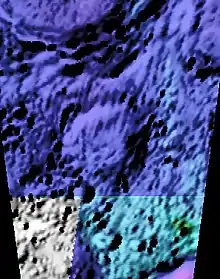Brashear (lunar crater)
Brashear is a lunar impact crater on the far side of the Moon, in the southern hemisphere in the vicinity of the south pole. The crater is named after the American astronomer John A. Brashear.[1] It lies just to the south of the walled plain Antoniadi, within the larger crater's outer rampart of ejecta. To the northeast besides Antoniadi is the crater Numerov, and southeast lies the younger De Forest.

 Clementine photo | |
| Coordinates | 73.5°S 171.6°W |
|---|---|
| Diameter | 60 km |
| Colongitude | 174° at sunrise |
| Eponym | John A. Brashear |
This formation is little more than a shallow depression in the lunar surface, its features eroded and blanketed by the ejecta from the relatively fresh crater Antoniadi just to the north.
The satellite crater Brashear P lies to the south-southwest. This formation is a heavily worn crater with features that have been almost completely worn away by subsequent impacts. Connected to the southern rim of this crater is a series of valleys and impact craters leading a couple of hundred kilometres to the east.
Satellite craters
By convention these features are identified on lunar maps by placing the letter on the side of the crater midpoint that is closest to Brashear.
| Brashear | Latitude | Longitude | Diameter |
|---|---|---|---|
| P | 76.8° S | 175.7° W | 71 km |
References
- "Brashear (lunar crater)". Gazetteer of Planetary Nomenclature. USGS Astrogeology Research Program.
- Andersson, L. E.; Whitaker, E. A. (1982). NASA Catalogue of Lunar Nomenclature. NASA RP-1097.
- Bussey, B.; Spudis, P. (2004). The Clementine Atlas of the Moon. New York: Cambridge University Press. ISBN 978-0-521-81528-4.
- Cocks, Elijah E.; Cocks, Josiah C. (1995). Who's Who on the Moon: A Biographical Dictionary of Lunar Nomenclature. Tudor Publishers. ISBN 978-0-936389-27-1.
- McDowell, Jonathan (July 15, 2007). "Lunar Nomenclature". Jonathan's Space Report. Retrieved 2007-10-24.
- Menzel, D. H.; Minnaert, M.; Levin, B.; Dollfus, A.; Bell, B. (1971). "Report on Lunar Nomenclature by the Working Group of Commission 17 of the IAU". Space Science Reviews. 12 (2): 136–186. Bibcode:1971SSRv...12..136M. doi:10.1007/BF00171763.
- Moore, Patrick (2001). On the Moon. Sterling Publishing Co. ISBN 978-0-304-35469-6.
- Price, Fred W. (1988). The Moon Observer's Handbook. Cambridge University Press. ISBN 978-0-521-33500-3.
- Rükl, Antonín (1990). Atlas of the Moon. Kalmbach Books. ISBN 978-0-913135-17-4.
- Webb, Rev. T. W. (1962). Celestial Objects for Common Telescopes (6th revised ed.). Dover. ISBN 978-0-486-20917-3.
- Whitaker, Ewen A. (1999). Mapping and Naming the Moon. Cambridge University Press. ISBN 978-0-521-62248-6.
- Wlasuk, Peter T. (2000). Observing the Moon. Springer. ISBN 978-1-85233-193-1.
External links
 Media related to Brashear (crater) at Wikimedia Commons
Media related to Brashear (crater) at Wikimedia Commons
